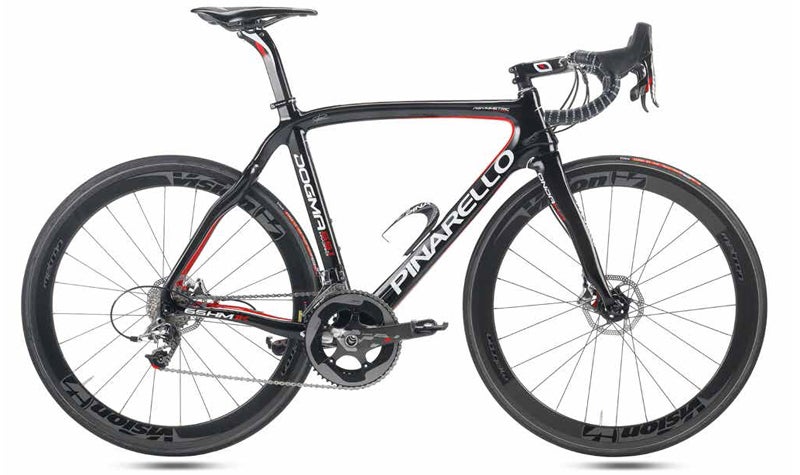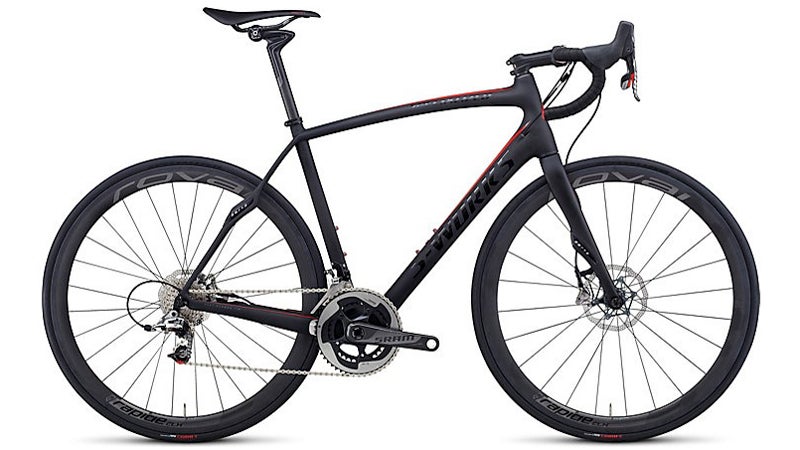No recent road bike technology has engendered more debate than disc brakes.
Traditionalists and some racers say that discs on road bikes are unnecessary, claiming the technology is a solution to a problem that doesnÔÇÖt exist. They argue that discs add complication, weight, and aerodynamic drag. Some even contend that they are .╠ř
Advocates argue that discs offer superior braking power and modulation relative to calipers. They say that the decoupling of the braking force from the rims vastly improves wheel safety, especially on carbon wheels that can be susceptible to failure when exposed to the heat generated from braking. And, proponents will tell you, in wet conditions, where rim brakes can be horrifying, discs are precise and reassuring.
But thereÔÇÖs no arguing that the technology is spreading. After launching disc road brakes last year, both SRAM and Shimano now have multiple models, with both hydraulic and mechanical versions and varying price options. And while discs on road bikes were the exception in 2014 (only six of the 32 test bikes in last yearÔÇÖs test featured them), manufacturers are clamoring to the technology for next year. At Interbike, virtually every bike company showed at least one or two disc road models for 2015. And some brands, such as Specialized, are even putting them on their top-range race bikes despite the fact that pro racers wonÔÇÖt be able to use them yet since the UCI hasnÔÇÖt approved the technology.
From what weÔÇÖve seen so far, which includes time on both bikes reviewed here, the┬áColnago C-59┬áwith Shimano hydraulic disc brakes, and half a dozen other disc models, weÔÇÖre convinced that disc brakes are the future for road bikes.
We’ve been riding both the , equipped with TRP Hy/Rd brakes, and the , with Avid BB7 Road SL mechanical discs, for over nine months. These two bikesÔÇöone a full-fledged racer, the other an endurance modelÔÇömay not make for a perfect comparison, but their early adoption of discs unites them. And in retrospect, weÔÇÖre glad to have tried the technology on two very different types of bikes because it gave us the chance to experience discs in a wider breadth of situations.
Pinarello Dogma 65.1 Hydro

Few bikes are as distinctive as the Dogma, the bike that Chris Froome rode to victory in the 2013 Tour de France. Though our model had discs and the BritonÔÇÖs did not, itÔÇÖs otherwise extremely similar, using the companyÔÇÖs top grade carbon fiber and retaining PinarelloÔÇÖs trademark asymmetric design. The asymmetry is less apparent here because, while the drive-side stays are oversized to accommodate the stress of the drivetrain, the opposite side of the bike is now beefed up to handle the additional braking force exerted by disc brakes. Another Pinarello signature, the wavy Onda fork, is also tempered and refined in this version, which we feel makes the bike look classier. With the gloss black finish set off by just a few hints of cherry red, this Dogma was one of the most coveted bikes in our entire test.
Our tester came equipped with a class-leading Shimano Dura-Ace Di2 component set, with shifting accuracy and certainty that stands well above anything on the market. The battery is hidden in an aero-style, house-brand Most seat post, and the integrated Most carbon stem and bar system is not only gorgeous and ergonomic, but it also has covered channels for smart internal cable routing in the cockpit.
Not everything on our bike was befitting the bikeÔÇÖs Tour-winning pedigree. The Vision Team 30 wheels, in particular, worked fine, but mating heavier aluminum wheels to such a premium carbon frame like this one, which is renowned for its cultivated road feel, is like complementing your skin suit on time trial day with a set of Mickey Mouse ears rather than an aero helmet. We loved the extra comfort of the 28mm Continental clinchers, but again itÔÇÖs a strange choice as, combined with the wheels, they made accelerations slow and ponderous.
[quote]ÔÇťIf the Roubaix rides like the bicycle version of a BMW rally car, the Pinarello is a Jaguar XK. ItÔÇÖs self-assured, glassy smooth, and unabashedly masculine.ÔÇŁ[/quote]
Then there were the TRP Hy/Rd brakes, likely chosen because neither the Shimano nor SRAM varieties were ready for production when Pinarello began shipping the Dogma Hydro. ThatÔÇÖs not to say that the TRPs are inferior; we think itÔÇÖs a smart design. The hydraulics are housed entirely in the brake caliper, eliminating the risk of bubbles in the line, and the action is by a standard mechanical cable so youÔÇÖre not limited to any brand or model of lever. The brakes held up perfectly throughout the length of the test, though overall testers felt they were slightly lacking in power compared to SRAM and Shimano hydraulics weÔÇÖve tried.╠ř
Any objections receded on the road, where the Dogma hummed along like the finely honed machine youÔÇÖd expect. As with all Pinarellos weÔÇÖve ridden before it, this Dogma has a certain sure, smooth road feel unlike other brands. If the Roubaix rides like the bicycle version of a BMW rally car, the Pinarello is a . ItÔÇÖs self-assured, glassy smooth, and unabashedly masculine. Geometry is long and low, just as youÔÇÖd want in a racer, and the bike made us feel like Valentino Rossi in corners.
While we appreciated the distinguished ride, we couldnÔÇÖt help but feel that the parts held back the bike. The wheel-tire set was over a pound heavier than the one on the Roubaix, which made the bike feel listless. At one point, we swapped in the Specialized hoops and, indeed, the Dogma came to life. The wheel choice is one we can overlook in the long termÔÇöafter all, the selection of disc-ready hoops was tiny until this year. Then again, at $13,000 for the bike as tested (and $5,300 for the frame set alone), one must expect perfection, and no carbon super bike can be considered perfect at 17.5 pounds. In that sense, the Dogma Hydro was a bike a little ahead of its time, with parts unequal to its exceptional frame quality. That issue will recede this year as a full spectrum of brakes and wheels become available (though at 900 grams for the frame, itÔÇÖs also true that the Dogma will never be the lightest bike around, no matter what parts are specÔÇÖd).
And to pre-empt the inevitable grousing over the eye-watering price: If youÔÇÖre serious about a Dogma, the cost wonÔÇÖt phase you. If the money bothers you, a Pinarello probably isnÔÇÖt for you. Remember, no one complains about the cost of a Lamborghini.
Specialized S-Works Roubaix SL4 Red Disc

The Roubaix is a very different bike from the Dogma, built by one of the most ubiquitous (read: least exclusive) bike brands in the world and engineered around ÔÇťenduranceÔÇŁ geometry. That means the wheelbase and chain stays are longer than on the Dogma, the bottom bracket is lower, and the head tube is taller, all of which equates to a more relaxed fit and stable ride.
Since its inception, the Roubaix has been defined by its Zertz inserts, elastomers built into the fork and seat stays to absorb road vibration, and they are still here, albeit in a new bolt-in design that should make service easier. Specialized has also incorporated elastomers into the CG-R seat post, which adds even more bump deflection. And the bike did, indeed, have a muted, softer edge than the Dogma on the rutted, chip-sealed back roads around northern New Mexico.
What we like about this Roubaix, however, is that while itÔÇÖs more comfortable and easier on the back than deeply dropped race bikes like the Dogma, itÔÇÖs no clunky, ÔÇťold manÔÇÖsÔÇŁ ride. Constructed from SpecializedÔÇÖs highest grade carbon fiber, the Roubaix SL4 is exceptionally light and snappy, and the parts selectionÔÇöincluding premium SRAM Red components, top-shelf carbon cockpit and sundries, and exceptionally fast and smooth house-brand Roval 40 Rapide CLX wheelsÔÇöis all oriented to performance and speed. In fact, these lightweight wheels, with their wide, domed profile are arguably the finest piece of engineering on the entire bike and some of the fastest disc wheels weÔÇÖve ridden.
[quote]ÔÇťUnlike PinarelloÔÇÖs unapologetic cost structure, Specialized is democratic. If you canÔÇÖt afford the top-spec model for $8,500, there are five versions of the Roubaix Disc, all in carbon, down to $1,950.ÔÇŁ[/quote]
Like the Dogma, the Roubaix was a bit of a victim of its early foray into discs, as the Red 22 Hydro models that came with the bike had to be returned because of . The company replaced them with Avid BB7 Road SL mechanical discs, and, despite the hiccup, we had no further issues. Since last winter, SRAMÔÇÖs hydraulic versions, which have more power and modulation than the mechanicals, have been re-engineered to eliminate the problems. But we would even choose the Avid mechanical discs over a set of rim brakes for their relative ease of braking and control.
ThatÔÇÖs how weÔÇÖd characterize the Roubaix on the whole: easy. We felt oddly upright after riding the Dogma, courtesy of that tall head tube, but once acclimated to the position, the bikeÔÇÖs low weight and fast wheels gave it the sensation of being more chipper than the Dogma. The steering wasnÔÇÖt quite as quick as the DogmaÔÇÖs, but then a steady, solid bike is sort of the point of the Roubaix. We preferred the hard-handling, carving manners of the Dogma through corners and tricky descents, where the Roubaix felt a bit more tentative. But on the other hand this felt like a bike that you could plow along on all day long.
Unlike PinarelloÔÇÖs unapologetic cost structure, Specialized is democratic. If you canÔÇÖt afford the top-spec model for $8,500 (which will increase to $9,500 for 2015), there are five versions of the Roubaix Disc, all in carbon, down to $1,950. You wonÔÇÖt get the same feathery weight, fast wheels, or component bling for that cost, but youÔÇÖll still benefit from the geometry and bump-eating technology, as well as the advantages of disc brakes.
Bottom Line
Comparing the Dogma to the Roubaix is a bit like pitting a against a ÔÇöboth are excellent machines, just different. The juxtaposition isnÔÇÖt quite that simple, though, as the Roubaix is almost two full pounds lighter than the Dogma Hydro and costs 35 percent less.
We acknowledge that the endurance geometry and supple road feel of the Roubaix wonÔÇÖt be for everyone. Several of our testers, mostly the ones who race, preferred the hard and fast feel of the Dogma, though almost every one of them was also amazed how quick and deft the new Roubaix was. But given that most riders arenÔÇÖt accustomed to the deep drop position and firm feel of a race bike, we wish that more people would at least consider endurance bikes. We bet that the average cyclist will likely feel better and enjoy riding more if they opt for the Roubaix or its ilk.
As for disc brakes, we canÔÇÖt say enough in their favor. On long descents, they provide amazing confidence and donÔÇÖt fatigue your hands in the same way as standard caliper models. We also love how, in tight corners, you could wait till later to brake, modulate the power better than with rim brakes, and come out relatively quicker every time.
[quote]ÔÇťAs for disc brakes, we canÔÇÖt say enough in their favor. On long descents, they provide amazing confidence and donÔÇÖt fatigue your hands in the same way as standard caliper models.ÔÇŁ[/quote]
The trump card is performance in the rain. One late-Spring day in Colorado, I rode a bike with carbon wheels and rim brakes down Cottonwood Pass in the sleet and snow, and was horrified. Not only was the stopping power atrocious, taking hundreds of feet once I got to speed, but my frigid hands became so fatigued that I could barely grip the levers. I swapped to a disc-brake equipped bike with carbon wheels for the second climb of the day, over Independence Pass, and though conditions deteriorated, the descent was easier, safer, and more comfortable by a factor of probably ten. At that moment, I decided I would never again own a road bike without discs.
With no standards yet for rotor size, hub configuration, and even hub width, it will be a while before discs are ready for the pro peloton. And there are still glitches and engineering issues being worked out, but thatÔÇÖs natural for such a new technology. They will be resolved, and, judging even by this yearÔÇÖs second generation of product, weight and size of disc brakes will soon equal rim varieties.
Objections will linger, but once the majority of riders realize the performance advantages, the quibbles will subside and disc brakes will become standard. Still not convinced? Just try and find a modern mountain bike with rim brakes.


